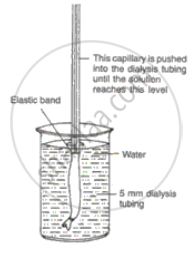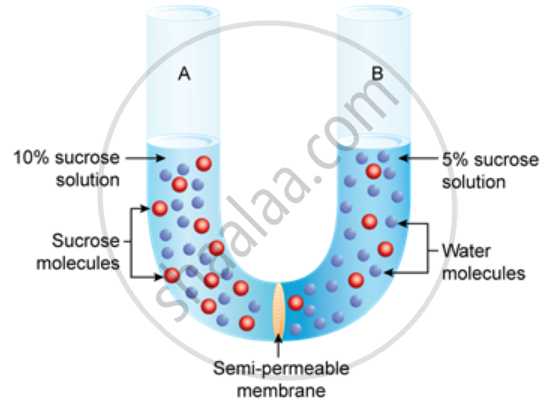Advertisements
Advertisements
Question
Given below is the diagram of a cell as seen under the microscope after having been placed in a solution:

(i) What is the technical term used for the state/condition of the cell given above?
(ii) Give the technical term for the solution in which the cell was placed.
(iii) Name the parts numbered 1 to 4.
(iv) Is the cell given above a plant cell or an animal cell ? Give two reasons in support of your answer as evident from the diagram.
(v) What would you do to bring this cell back to its original condition?
Solution
(i) Plasmolysis
(ii) Hypertonic solution
(iii) (1) Nucleus, (2) Sugar drops, (3) Small vacuole, (4) Large vacuole.
(iv) Plant cell (1) Presence of cell wall, (2) Presence of large vacuole.
(v) It has to be placed in a hypotonic solution.
APPEARS IN
RELATED QUESTIONS
What part is played by the cell wall?
The apparatus arranged alongside signifies an important process.
(i) Name the process.
(ii) Where does this process occur in plants?
(iii) What solution is placed inside the dialysis tubing?
(iv) What happens to the level of the solution in the capillary tube?

Choose the correct answer:
Absorption of water from soil takes place by __________
Study the experimental setup in the figure and then answer the question that follow.

Explain the phenomenon mention in question 8.1 .
Differentiate between the following
Permeable and Semi-permeable membrane.
Column ‘II’ is a list of items related to ideas in Column ‘I’. Match the term in Column ‘II’ with a suitable idea given in Column ‘I’.
| Column I | Column II |
| (i) Diffusion | (a) The exit or flow of water from the cell to the outer environment. |
| (ii) Xylem | (b) The shrinkage of protoplasm when the cell is kept in a hypertonic solution. |
| (iii) Root pressure | (c) The tissue through which water and mineral salts move upward in a plant. |
| (iv) Isotonic solution | (d) Two solutions which have equal osmotic pressure. |
| (v) Exosmosis | (e) The process by which the molecules of perfume spread in the room when the bottle is open. |
| (vi) Osmosis | (f) The process by which roots absorb water from the soil. |
| (vii) Plasmolysis | (g) The pressure by which water rises up to some feet in a lofty tree. |
| (viii) Hypotonic solution | (h) The concentration of the solution when lower than that of the cell sap. |
Most plant cells and tissues constitutes _____ % water.
Which part of the root helps in maximum absorption of water and minerals?
They are pipe-like, consisting of a group of specialised cells. They transport substances and form two-way traffic in plants. Which of the following terms qualify for the features mentioned above?
Draw a neat and proportionate diagram of root hair and label mitochondria, nucleus and vacuole.
